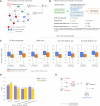Network medicine framework reveals generic herb-symptom effectiveness of traditional Chinese medicine
- PMID: 37889962
- PMCID: PMC10610911
- DOI: 10.1126/sciadv.adh0215
Network medicine framework reveals generic herb-symptom effectiveness of traditional Chinese medicine
Abstract
Understanding natural and traditional medicine can lead to world-changing drug discoveries. Despite the therapeutic effectiveness of individual herbs, traditional Chinese medicine (TCM) lacks a scientific foundation and is often considered a myth. In this study, we establish a network medicine framework and reveal the general TCM treatment principle as the topological relationship between disease symptoms and TCM herb targets on the human protein interactome. We find that proteins associated with a symptom form a network module, and the network proximity of an herb's targets to a symptom module is predictive of the herb's effectiveness in treating the symptom. These findings are validated using patient data from a hospital. We highlight the translational value of our framework by predicting herb-symptom treatments with therapeutic potential. Our network medicine framework reveals the scientific foundation of TCM and establishes a paradigm for understanding the molecular basis of natural medicine and predicting disease treatments.
Figures




References
-
- E. Raviña Rubira, The Evolution of Drug Discovery: From Traditional Medicines to Modern Drugs (Wiley-VCH, 2011).
-
- L. Li, H. Yao, J. Wang, Y. Li, Q. Wang, The role of chinese medicine in health maintenance and disease prevention: Application of constitution theory. Am. J. Chin. Med. 47, 495–506 (2019). - PubMed
-
- X. Zhou, Y. Li, Y. Peng, J. Hu, R. Zhang, L. He, Y. Wang, L. Jiang, S. Yan, P. Li, Q. Xie, B. Liu, Clinical phenotype network: The underlying mechanism for personalized diagnosis and treatment of traditional Chinese medicine. Front. Med. 8, 337–346 (2014). - PubMed
-
- S. Jafari, M. Abdollahi, S. Saeidnia, Personalized medicine: A confluence of traditional and contemporary medicine. Altern. Ther. Health Med. 20, 31–40 (2014). - PubMed
MeSH terms
Substances
Grants and funding
LinkOut - more resources
Full Text Sources

